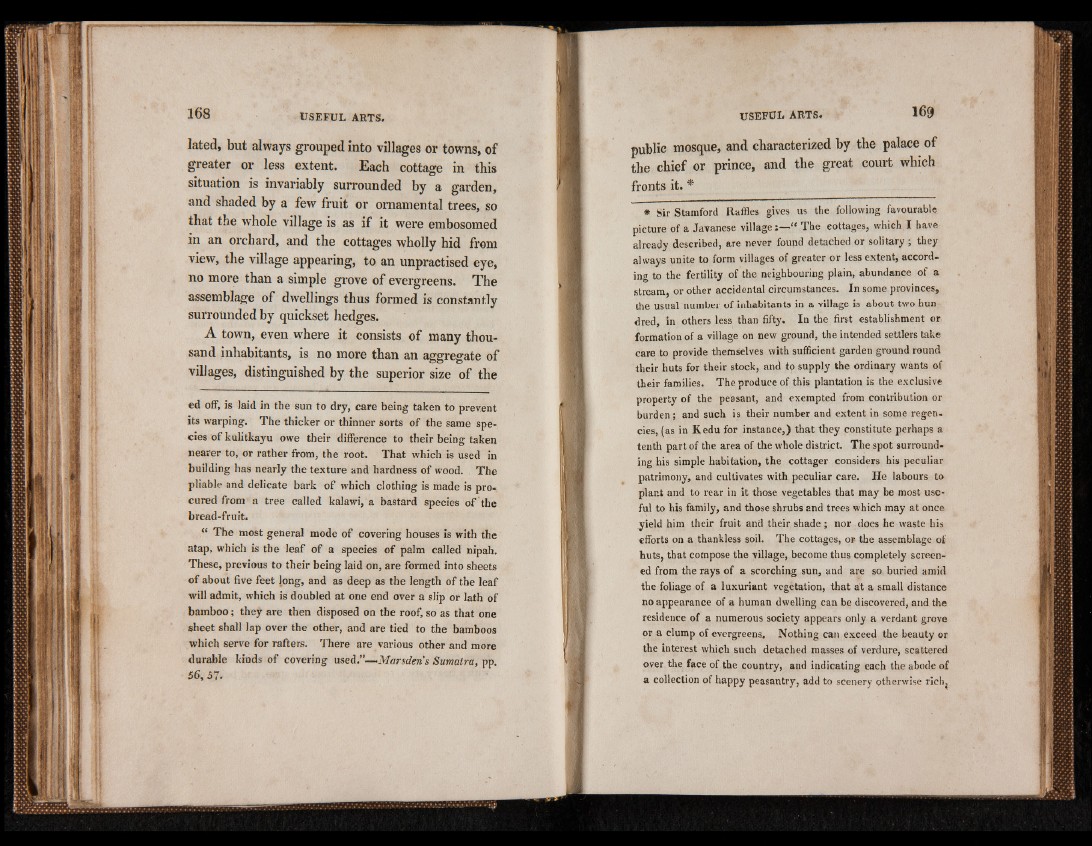
lated, but always grouped into villages or towns, of
greater or less extent. Each cottage in this
situation is invariably surrounded by a garden,
and shaded by a few fruit or ornamental trees, so
that the whole village is as if it were embosomed
in an orchard, and the cottages wholly hid from
view, the village appearing, to an unpractised eye,
no more than a simple grove of evergreens. The
assemblage of dwellings thus formed is constantly
surrounded by quickset hedges.
A town, even where it consists of many thousand
inhabitants, is no more than an aggregate of
villages, distinguished by the superior size of the
ed off, is laid in the sun to dry, care being taken to prevent
its warping. The thicker or thinner sorts of the same species
of kulitkayu owe their difference to their being taken
nearer to, or rather from, the root. That which is used in
building has nearly the texture and hardness of wood. The
pliable and delicate bark of which clothing is made is procured
from a tree called kalawi, a bastard species of the
bread-fruit.
“ The most general mode of covering houses is with the
atap, which is the leaf of a species of palm called nipah.
These, previous to their being laid on, are formed into sheets
of about five feet long, and as deep as the length of the leaf
will admit, which is doubled at one end over a slip or lath of
bamboo; they are then disposed on the roof, so as that one
sheet shall lap over the other, and are tied to the bamboos
which serve for rafters. There are various other and more
durable kinds of covering used.”— Marsderis Sumatra, pp.
56,57.
public mosque, and characterized by the palace of
the chief or prince, and the great court which
fronts it. *
* Sir Stamford Raffles gives us the following favourable
picture of a Javanese v i l l a g e “ The eottages, which I have
already described, are never found detached or solitary ; they
always unite to form villages of greater or less extent, according
to the fertility of the neighbouring plain, abundance of a
stream, or other accidental circumstances. In some provinces,
the usual number of inhabitants in a village is about two hundred,
in others less than fifty. In the first establishment or
formation of a village on new ground, the intended settlers take
care to provide themselves with sufficient garden ground round
their huts for their stock, and tp supply the ordinary wants of
their families. The produce of this plantation is the exclusive
property of the peasant, and exempted from contribution or
burden; and such is their number and extent in some regencies,
(as in Kedu for instance,) that they constitute perhaps a
tenth part of the area of the whole district. The spot surrounding
his simple habitation, the cottager considers his peculiar
patrimony, and cultivates with peculiar care. He labours to
plant and to rear in it those vegetables that may be most useful
to his family, and those shrubs and trees which may at once
.yield him their fruit and their shade ; nor does he waste his
efforts on a thankless soil. The cottages, or the assemblage of
huts, that compose the village, become thus completely screened
from the rays of a scorching sun, and are so buried amid
the foliage of a luxuriant vegetation, that at a small distance
no appearance of a human dwelling can be discovered, and the
residence of a numerous society appears only a verdant grove
or a clump of evergreens. Nothing can exceed the beauty or
the interest which such detached masses of verdure, scattered
over the face of the country, and indicating each the abode of
a collection of happy peasantry, add to scenery otherwise rich^